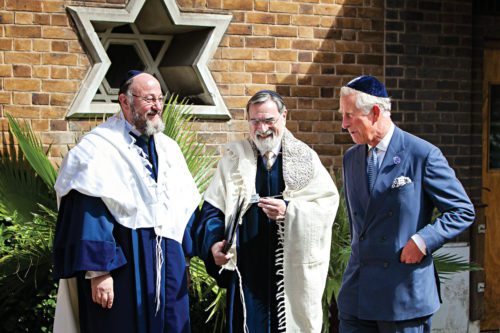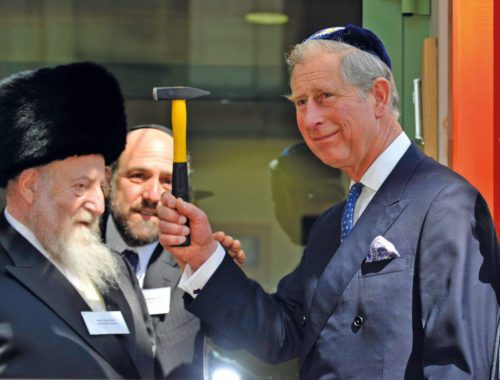
Prince Charles at 70: How he has gone above and beyond to support Anglo-Jewry
On the 70th birthday of the heir to the throne, UK Jewish leaders hail the future king’s backing for the community
A joke story suggesting Prince Charles was converting to Judaism four years ago remains Jewish News’ most clicked-on Purim spiel to date.
Perhaps it was the fact he boasts the most famous kippah in Britain – a velvet head covering emblazoned with his royal crest – that gave the story even a shred of credibility. More likely, though, it was the number of engagements he has undertaken in the community over the years – and the enthusiasm with which he has thrown himself into causes close to communal hearts.
From Bevis Marks’ tercentenary service and lighting Chanukah candles with schoolchildren to his attendance at the installment of the chief rabbi and support for Holocaust remembrance, the future king has been at the forefront of the Royal Family’s close ties with Anglo-Jewry and other minority communities.
But it was his crucial role in bringing about the Jewish community centre in Krakow where his support for Shoah survivors began more than a decade ago. So moved was he by the plight of the city’s elderly residents, who faced poverty after living through the horrors of the Shoah, that he returned to the UK with the idea of creating an old age home for them.
World Jewish Relief was approached for help and, after extensive research, recommended to the the Prince of Wales that his vision would best be met with a new community hub where survivors could meet in comfort while mingling with younger community members.

Chief Rabbi Mirvis, former Chief Rabbi, Rabbi Lord Sacks, and HRH Prince Charles
Charles put his “heart and soul” into the project, according to Nigel Layton, the charity’s former chair. That included making a personal donation to “talking about it all the time and holding events” and even flying to Poland to help affix a mezuzah at the facility’s opening on 29 April 2008. “The project would not have happened without him,” he said. “It isn’t one of the countries we normally operated in but the opportunity to engage in Jewish renewal in a town where communal life was obliterated was fantastic. Every time I go I meet someone who has just found their Jewish roots and the centre. We’ve now got thousands of members, having opened with only had a handful.”

Along with the Holocaust Memorial Day Trust and the Jewish museum, WJR enjoys the patronage of the future king, who has now moved on to helping the charity’s project to repair the homes of elderly people in Ukraine. But, like his royal responsibilities, his interest in the Krakow centre looks set to be life-long. “He still asks for updates every six months and sent a message for our 10th anniversary,” said Layton. “When he really believes in something he takes the time to understand the issues and people involved. We couldn’t have asked for more.”
t was learning about WJR’s role in the rescue of 10,000 children that kick-started an association with those who came on the kindertransport (including my grandma) that has so far seen Charles host and attend gatherings marking the 70th and 75thanniversaries of the operation.
Chief Rabbi Mirvis: Let’s drink a l’chaim to a dear friend’s 70th
Eve Willmann, 85, who arrived from Vienna aged just five, spoke of the “fizzle of excitement” she always feels at meeting someone who has done so much for remembrance. “You’ve no idea what the scrum is like to shake his hand,” she said.
“He represents what England did to save 10,000 children and he has taken it on.” As the group she is part of – the Association of Jewish Refugees kinder committee – is busy encouraging younger generations to ensure the memory is passed on, Williams hopes Charles will continue to shine a light on the issue for decades to come. “It’s so important because a lot of the public don’t know about the Holocaust,” she adds.
Prince Charles meets Kindertransport refugees, including Eve Willmann at the AJR performance of Last Train to Tomorrow at The Roundhouse, London.
Blake Ezra Photography.
If a man should be judged by his friends, then Charles must be a good place to count on the effusive support of The Sun’s veteran photographer Arthur Edwards, who last month skipped the first major foreign tour by Prince Harry and Meghan to join Charles in Africa. “If he wanted me to take a pic for him tomorrow I’d drop everything,” he said.
“He’s like a Duracell bunny – he just keeps on going. No one will refuse to come to lunch with the Prince of Wales and he uses the power of his office to do great things.” But Edwards – who has undertaken more than 120 foreign tours with the Prince – said the “self-deprecating” royal doesn’t get the praise he deserves for supporting those in need, including the fact his charities raise more than £100m annually, and had faced ridicule where he should have been seen as a “visionary” for his outspoken views.
Like The Queen, he insists, Charles’ record is the ultimate retort to those who knock the Monarchy. The Prince still visits a family who in Cumbria whose bed and breakfast he stayed in at the time of the foot and mouth crisis. Then, Edwards recalled, there was the time HRH came up with the idea of hosted a palace reception for Page 3 girls to support a youth club in Burnley.
For him, despite having covered tens of thousands of events over 40 years, the Krakow project stands out as symbolising how the Prince goes above and beyond. In a book celebrating Charles, Edwards has included an image from the opening of a survivor with HRH “looking so happy wearing his decorated kippah. When you know the history of Krakow it was just a really great thing. I’ve told several people about it over the years”.
Last year, Charles faced criticism over the emergence of a private letter from 1986 in which he appeared to blame “an influx of foreign Jews” for Middle East unrest and urged the US to “Take on the Jewish lobby”. Clarence House moved quickly to insist he was simply reflecting the views of some he had met in the region, rather than his own.
But, as the 70-year absence of an official royal visit to Israel ended with a trip by Prince William, the heir to the throne joined the community’s main celebration for the Jewish state’s own 70th birthday. He also attended the funerals of both Yitzhak Rabin and Shimon Peres.
It was on the plane back from the former that he first had a lengthy conversation with Lord Sacks – the start of a friendship that later saw him attend his farewell gala as chief rabbi. “What I really loved on that occasion is how he spent as much time with the children’s choir as he spent with the great and good of Anglo-Jewry,” he said. “His greatness is his humility.”
He added: “He has a record of making a difference to lives that needed that difference which is probably as great as anyone in the history of the Monarchy. He can be proud of all he has achieved and full of confidence in everything that remains for him to achieve.”
Commenting on his pledge to be “defender of faith” when he becomes King, Lord Sacks said: “What he is saying is that because of his own Christian beliefs he can respect other people’s different religious beliefs. He’s reflecting the diversity of Britain. The Queen has in her own way reflected this so he’s continuing a fine family tradition.”
And it is on a personal level as well as a macro one that he has left an impression on the emeritus chief rabbi, who recalls: “When my father died I received 600 letters but only one was handwritten and six pages long.”But it is perhaps through the Prince’s Trust, which he set up in 1976 and has helped over 900,000 disadvantaged young people, that he’s had the greatest impact. Prince’s Trust International chair Sir Lloyd Dorfman said: “The Prince’s Trust is a great example of how Royals can make a difference. In my travels, people have commented how fortunate we are to have such a system.
“I have seen the Prince in action at close quarters and know how passionate and engaged he is. Through his philanthropy, he has transformed lives.”
It’s clear that the community’s admiration for the Prince is reciprocated by the royal – from Jewish faith schools to Anglo-Jewry’s support for other community’s abroad to the resilience of survivors like Sir Ben Helfgott. He told last year’s WJR dinner that his own family’s links with the community – including his grandmother’s saving of Jews during the Shoah and his attendance in the 1960s at a school where he was taught by Jewish immigrants – helped inspire his own efforts to each across communities.
Source: Jewish News